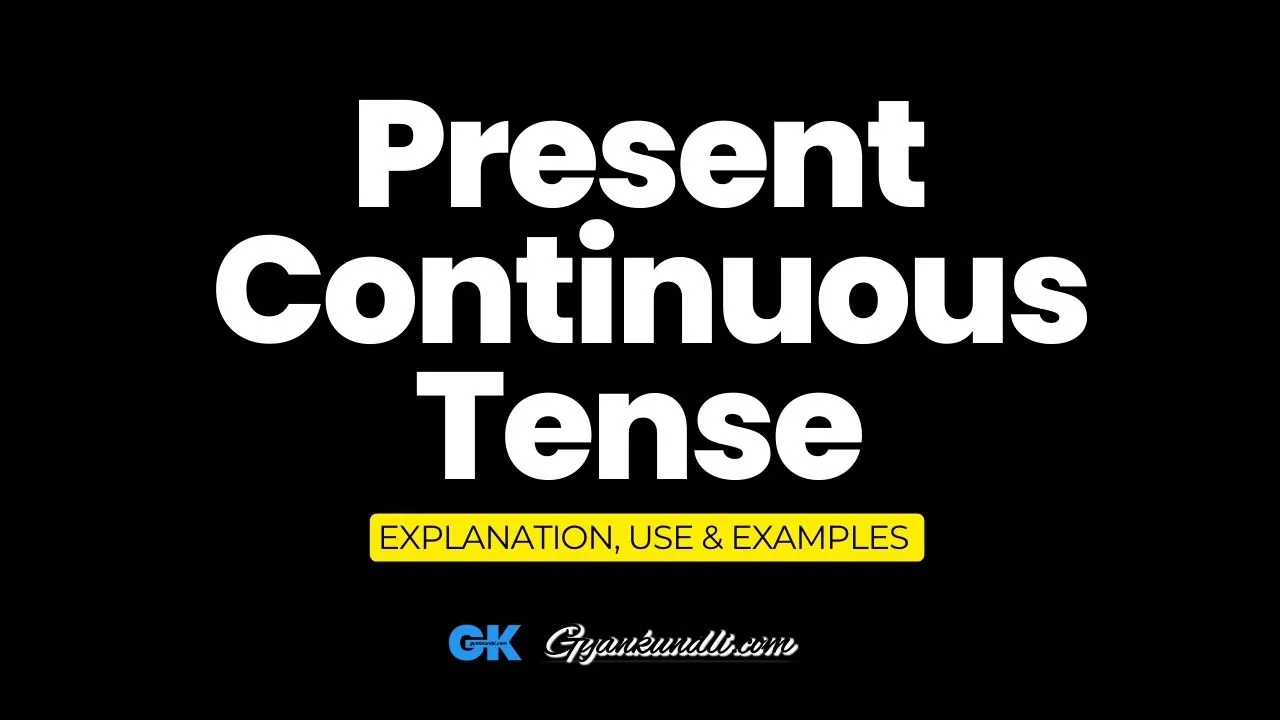The Present Continuous Tense, also known as the Present Progressive Tense, is a verb tense used to describe temporary actions that are currently taking place, or to describe future plans.
The Present Continuous Tense denotes that actions are in progress at the time of speaking. It indicates that an action is happening right now.
Present Continuous Tense: Form
We use is, am, are + -ing form of the verb. ( Present tense of the auxiliary verb BE + the present participle)
| Pronouns | Affirmative | Negative | Interrogative |
|---|---|---|---|
| I | I am reading. | I am not reading. | Am I reading? |
| He/She/It | He/She is reading. | He/She is not reading. | Is he/she reading? |
| You | You are reading. | You are not reading. | Are you reading? |
| We | We are reading. | We are not reading. | Are we reading? |
| They | They are reading. | They are not reading. | Are they reading? |
Spelling of -ing Form of the Verb or Present Participle
Verb ending in a single e, we drop e before –ing :
love → loving
care → caring
make → making
hope → hoping
write → writing
Verb of one syllable having one vowel + ending with single consonant, we double the consonant before -ing:
cut→ cutting
rub → rubbing
stop → stopping
get → getting
When verb ends in -ee, -ye, then final -e is not dropped while adding -ing:
see → seeing
dye → dyeing
We change -ie to -y when we add -ing :
die →dying
lie →lying
When a verb is ending in single vowel + l, we double l while adding -ing :
signal → signalling
travel → travelling
Present Continuous Tense : Use
Present Continuous Tense is used for an action that is happening now or at the time of speaking:
- It is raining.
- What are you doing with that knife?
- Why are you looking at me like that?
Present Continuous Tense is used for repeated actions and events, if these actions or events are just happening around the present:
- Why is he hitting the donkey?
Present Continuous Tense is also used to talk about developments, changes or trends:
- I am beginning to realise how difficult it is to be a teacher.
- Is your English getting better?
- That child is getting bigger every day.
- Gold prices are going up again.
Present Continuous Tense is used to imply that a situation is or may be temporary:
- Banks are lending more money to encourage businesses to grow. ( It implies that it is a temporary arrangement not permanet.)
Present Continuous Tense is used for future actions and events that have some present reality. ( Fixed plans, personal arrangements) :
- I am seeing my brother on Friday.
- My bike is going in for repairs next week.
Adverbs Used in Present Continuous Tense
Here’s a list of adverbs commonly used in the present continuous tense:
- Currently
- Presently
- Now
- At the moment
- Right now
- Nowadays
- Today
- This week/month/year
- At present
- These days
- In the meantime
- For the time being
- For now
Check out our previous post : Present Simple Tense : Explanation and Examples
Present Continuous Tense : Examples
1. She is currently studying for her exams.
2. Presently, he is working on a new project.
3. We are busy now preparing for the party.
4. I’m sorry, I can’t talk, I’m focusing on my work at the moment.
5. They are right now discussing the details of the plan.
6. They are closing the store temporarily for renovations.
7. Nowadays, people are relying more on technology for communication.
8. We are meeting our friends for lunch today.
9. She is learning Spanish these days.
10. The company is experiencing growth this month.
11. The team is working hard this year to achieve its goals.
12. At present, I am working on my blog post.
13. These days, social media plays a significant role in our lives.
14. These days, everyone seems to be busy with their own schedules.
15. In the meantime, I will finish this task.
16. For the time being, let’s focus on completing this project.
17. They are currently renovating their house.
18. I am presently writing an article for my blog.
19. We are now discussing our travel plans for the summer.
20. He’s at the moment attending a conference in Paris.
21. They are right now preparing dinner in the kitchen.
22. They are closing the shop temporarily for inventory checks.
23. Nowadays, people are preferring online shopping over traditional methods.
24. We are going to the beach today.
25. She is volunteering at the local shelter this week.
26. The company is launching a new product this month.
27. He is focusing on improving his skills this year.
28. At present, I am reading a new book.
29. Now, it is raining heavily.
30. These days, more students are opting for online education.
Discover more from Gyankundli
Subscribe to get the latest posts sent to your email.




















2 thoughts on “Present Continuous Tense : Explanation, Use and Examples”